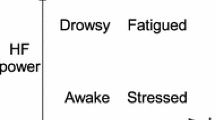Abstract
Among the numerous factors that are responsible for increasing road accidents, the second most common cause is drowsiness. In an attempt to reduce the rate of accidents, we propose a system which would efficiently handle the timely detection of drowsiness and would accordingly curb the speed of the vehicle being driven. As a proof of concept of the proposed method, we have trained the SVM classifier on the EEG (electroencephalogram) waves derived from “Analysis of a sleep-dependent neuronal feedback loop: the slow-wave micro continuity of the EEG” by Kemp et al. [1, 2]. The data is obtained from a wireless EEG headset. The classification results will determine whether the EEG data corresponds to drowsiness or alertness. This level of drowsiness is then used to determine the maximum speed limit. As the work in [3] has stated, there is a strong correlation between the number of accidents and the speed limit. Hence altogether, the proposed system integrates EEG waves for sleep level detection, and speed lock as a preventive measure to reduce the number of plausible accidents.
Access this chapter
Tax calculation will be finalised at checkout
Purchases are for personal use only
Similar content being viewed by others
References
Kemp, B., Zwinderman, A.H., Tuk, B., Kamphuisen, H.A.C., Oberyé, J.J.L.: Analysis of a sleep-dependent neuronal feedback loop: the slow-wave microcontinuity of the EEG. IEEE-BME 47(9), 1185–1194 (2000)
Goldberger, A.L., Amaral, L.A.N., Glass, L., Hausdorff, J.M., Ivanov, P.C., Mark, R.G., Mietus, J.E., Moody, G.B., Peng, C.-K., Stanley, H.E.: PhysioBank, PhysioToolkit, and PhysioNet: components of a new research resource for complex physiologic signals. Circulation 101(23), e215–e220 (2000). [Circulation Electronic Pages; http://circ.ahajournals.org/cgi/content/full/101/23/e215]
https://ec.europa.eu/transport/road_safety/specialist/knowledge/speed/speed_is_a_central_issue_in_road_safety/speed_and_accident_risk_en. Accessed 31 Aug 2018
Nilsson, G.: Traffic safety dimensions and the power model to describe the effect of speed on safety. Bulletin 221, Lund Institute of Technology, Lund (2004)
Yeo, M.V.M., Li, X., Shen, K., Wilder-Smith, E.P.V.: Can SVM be used for automatic EEG detection of drowsiness during car driving? Saf. Sci. 47(1), 115–124 (2009). ScholarBank@NUS Repository
Wheaton, A.G., Chapman, D.P., Presley-Cantrell, L.R., Croft, J.B., Roehler, D.R.: Drowsy driving: 19 states and the District of Columbia, 2009–2010.[630 KB] MMWR Morb Mortal Wkly Rep. 2013; 61:1033
Wheaton, A.G., Shults, R.A., Chapman, D.P., Ford, E.S., Croft, J.B.: Drowsy driving and risk behaviors: 10 states and Puerto Rico, 2011–2012.[817 KB] MMWR Morb Mortal Wkly Rep. 2014; 63:557–562
https://www.cdc.gov/features/dsdrowsydriving/index.html. Accessed 31 Aug 2018
Dangra, B.S., Bedekar, M., Panicker, S.S.: User profiling of automobile driver and outlier detection, 3(12) (2014). ISSN 2278 - 0211, (Special Issue)
Author information
Authors and Affiliations
Corresponding author
Editor information
Editors and Affiliations
Rights and permissions
Copyright information
© 2019 Springer Nature Switzerland AG
About this paper
Cite this paper
Ghube, C., Kulkarni, A., Bankar, C., Bedekar, M. (2019). BMI Application: Accident Reduction Using Drowsiness Detection. In: Abraham, A., Gandhi, N., Pant, M. (eds) Innovations in Bio-Inspired Computing and Applications. IBICA 2018. Advances in Intelligent Systems and Computing, vol 939. Springer, Cham. https://doi.org/10.1007/978-3-030-16681-6_7
Download citation
DOI: https://doi.org/10.1007/978-3-030-16681-6_7
Published:
Publisher Name: Springer, Cham
Print ISBN: 978-3-030-16680-9
Online ISBN: 978-3-030-16681-6
eBook Packages: Intelligent Technologies and RoboticsIntelligent Technologies and Robotics (R0)




